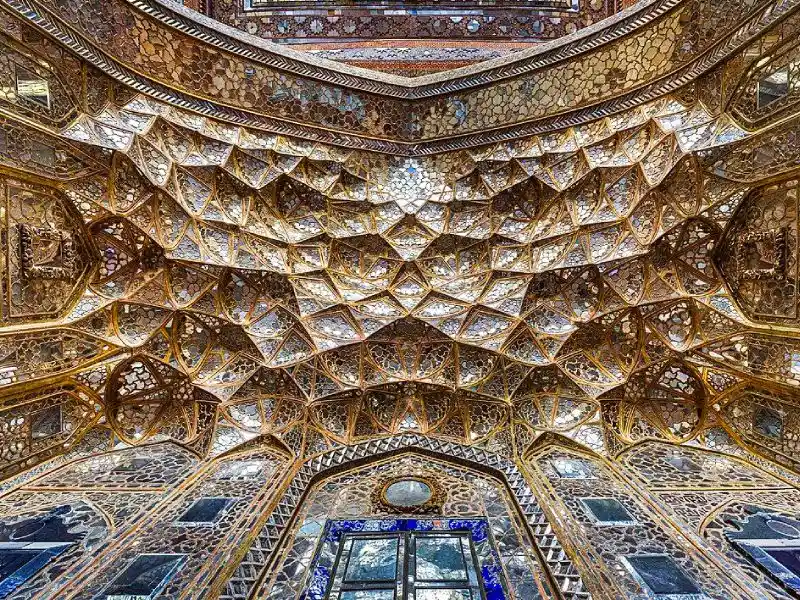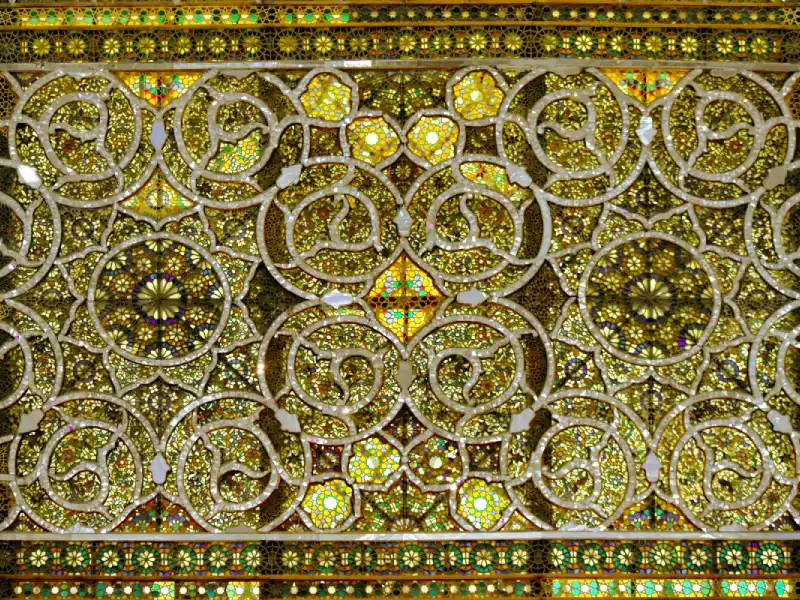What Is Persian Mirror Art (Aina Kari)?
Aina Kari, or Persian mirror art, is a traditional Iranian decorative technique that transforms mirrors into stunning works of art. This intricate craft involves the delicate cutting and arranging of small mirror pieces into geometric and floral patterns, reflecting light in dazzling, kaleidoscopic designs. Aina Kari has been used for centuries to embellish the interiors of palaces, mosques, and historical buildings in Iran, adding a sense of luxury and brilliance to the architecture. Rooted in Persian culture and artistry, this unique craft exemplifies the beauty and precision of Iranian craftsmanship, making it a cherished element of the country’s cultural heritage. Let’s learn more about the fascinating Persian mirror art!
Persian Mirror Art History
The history of Persian mirror art dates back to the Safavid era in the 16th century, a time when the Persian Empire was flourishing in art, culture, and architecture. Mirror work, known as Aina Kari, was introduced in Iran when imported European mirrors arrived in the country.
Initially, mirrors were brought in as large sheets, but many were broken during transportation. Instead of discarding the shattered pieces, skilled Persian craftsmen transformed them into intricate patterns, giving birth to a unique art form that soon became a hallmark of Persian architectural beauty.
Aina Kari became particularly prominent during the Qajar period (late 18th to early 20th century), as it was favored by royalty for decorating palaces and important buildings. The reflective and elaborate nature of the mirror work was seen as a symbol of wealth, power, and divine beauty, making it a preferred choice for the decoration of royal structures.
It was during this time that the art form evolved, with artisans experimenting with complex geometric patterns and floral motifs. The mirror pieces were carefully cut and arranged to create mesmerizing designs, reflecting light in a way that made rooms appear brighter and more spacious.
Some of the most famous examples of Persian mirror art can be seen in Golestan Palace in Tehran, where the Hall of Mirrors (Talar-e Ayeneh) showcases some of the finest Aina Kari work in the country.
Other notable examples include the Narenjestan Qavam in Shiraz and the Ali Qapu Palace in Isfahan. These buildings are adorned with intricate mirror mosaics that reflect the artistry and craftsmanship of Persian artisans, offering visitors a glimpse into the grandeur of Iran’s architectural heritage. The shimmering beauty of Persian mirror art continues to captivate observers, preserving its legacy as one of Iran’s most exquisite cultural treasures.
Persian Mirror Art Style
Persian Mirror Art Style is renowned for its intricate geometric patterns and delicate floral motifs, which are created by carefully arranging tiny mirror pieces. The craftsmanship involved in this art form is highly detailed, with artisans using precise cutting techniques to shape mirrors into symmetrical forms.
The reflective nature of the mirrors amplifies light and creates a dazzling, almost magical, effect in the spaces where this art is applied. These mirror patterns are often combined with other traditional Persian decorative elements, such as tile work or stucco, blending different art forms seamlessly to enhance the beauty of architectural interiors.
One of the most defining characteristics of the Persian Mirror Art Style is its ability to transform ordinary rooms into stunning spaces that feel larger and more radiant. The use of mirrors reflects light in multiple directions, creating an atmosphere of luxury and opulence. This style has been widely used in royal palaces, mosques, and important cultural landmarks across Iran.
The precision and creativity of the Persian Mirror Art Style continue to inspire contemporary artists and designers, who incorporate this centuries-old technique into modern architecture, keeping its legacy alive.
Persian Mirror Art Patterns
The intricate geometric designs of Persian mirror art patterns are well-known and often draw inspiration from nature and Islamic artistic customs. Artisans carefully arrange small fragments of mirrors to create symmetrical shapes, such as stars, flowers, and intricate interlocking patterns.
These designs not only add aesthetic value but also have symbolic meanings, reflecting the harmony and balance found in nature and the universe. The mirror fragments are placed in a way that reflects light from various angles, creating a dynamic and luminous effect that enhances the beauty of architectural spaces.
A stunning example of these patterns can be seen in the Chehel Sotoun Palace in Isfahan, where the mirror work is particularly remarkable. The palace’s Hall of Mirrors is adorned with delicate and detailed Aina Kari that transforms the room into a shimmering spectacle of light and reflection.
The mirror mosaics in Chehel Sotoun are arranged in floral and geometric patterns, which capture and scatter light, illuminating the space with an ethereal glow. This masterful use of mirror art highlights the exceptional skill of Persian craftsmen and demonstrates how mirror work has been an integral part of Iranian architectural heritage.
Persian Mirror Work
Persian Mirror Work, known as Aina Kari, holds significant value in Persian culture and history, symbolizing beauty, craftsmanship, and artistic innovation. For centuries, this intricate art form has been used to adorn palaces, mosques, and cultural landmarks, representing the opulence and refinement of Persian architecture.
The reflective nature of the mirror work is not only visually striking but also carries deeper symbolic meaning in Persian culture, where light is often associated with spirituality and divine presence. By scattering light in mesmerizing patterns, Persian Mirror Work creates a sense of harmony and serenity, elevating both the aesthetic and spiritual atmosphere of a space.
Its enduring presence in Iran’s most iconic buildings reflects the nation’s deep appreciation for art, craftsmanship, and the preservation of its rich cultural heritage.
Safavid Glass & Mirror
During the Safavid era, glass and mirror work flourished, marking a significant period in Persian decorative arts. Mirrors were initially imported from Europe and became a luxury item reserved for royalty and the elite. During the Safavid period, mirror work symbolized not only wealth and power but also divine light, reflecting the Safavids’ deep spiritual beliefs.
The fragmented mirrors were arranged in geometric and floral patterns, often representing cosmic order and harmony, blending beauty with symbolic meanings. This mirror work became a visual representation of the heavenly realm, illuminating spaces with light that was thought to connect the physical and spiritual worlds.
Last Words
Persian Mirror Art demonstrates the skill and artistry of Iranian craftsmen, combining beauty with cultural and spiritual importance. This intricate art form, which originated from the creative repurposing of shattered mirrors, has evolved over centuries into a symbol of luxury, light, and harmony. Found in some of Iran’s most iconic palaces and religious buildings, Persian Mirror Art not only enhances the architectural beauty of these structures but also reflects the deep-rooted connection between Persian culture, craftsmanship, and the divine. Its enduring presence continues to captivate admirers, ensuring that this unique art form remains an integral part of Iran’s rich cultural heritage.
Are you planning to travel to Iran and looking for an Iran travel agency? Check out our Iran tours.









Leave a Reply
Want to join the discussion?Feel free to contribute!